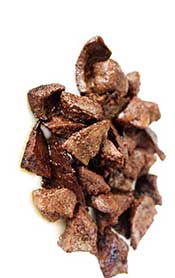Otherwise known as offal, organ meats are even more nutritious than regular red and white meat.
Organ meats were once a common and popular food choice, but they have fallen out of favor in recent years.
This is a shame because these traditional meats are some of the healthiest and most nutrient-dense foods we can eat.
This article provides a list of 10 healthy kinds of organ meat alongside their nutrition profiles and key benefits.
Note: all nutrition data is from the USDA’s nutrient database, and the values are before cooking.
1) Beef Liver
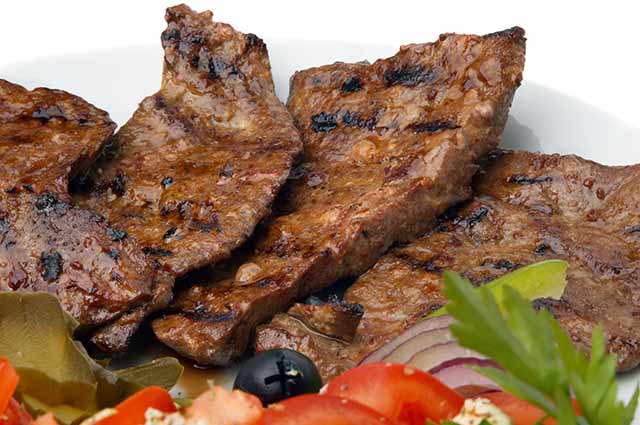
Beef liver is one of the most popular organ meat choices, and it is among the most nutrient-dense of all foods.
Compared to regular beef, this organ meat offers the same protein content and significantly more nutrients for fewer calories.
There are many ways to eat beef liver, but one of the most popular is to fry it alongside some onions.
Nutrition Facts
Beef liver provides the following nutrients per 100 grams;
| Nutrient | Amount |
| Calories | 135 kcal |
| Carbohydrate | 3.9 g |
| Fat | 3.6 g |
| Saturated Fat | 1.2 g |
| Monounsaturated Fat | 0.5 g |
| Polyunsaturated Fat | 0.5 g |
| Protein | 20.4 g |
| Vitamin A | 338% DV |
| Vitamin C | 2% DV |
| Vitamin D | Varies |
| Vitamin E | 2% DV |
| Vitamin K | 4% DV |
| Vitamin B1 | 13% DV |
| Vitamin B2 | 162% DV |
| Vitamin B3 | 66% DV |
| Folate | 72% DV |
| Vitamin B5 | 72% DV |
| Vitamin B6 | 54% DV |
| Vitamin B12 | 988% DV |
| Calcium | 1% DV |
| Copper | 488% DV |
| Iron | 27% DV |
| Magnesium | 5% DV |
| Manganese | 16% DV |
| Phosphorus | 39% DV |
| Potassium | 9% DV |
| Selenium | 57% DV |
| Sodium | 3% DV |
| Zinc | 27% DV |
Benefits
- Beef liver provides a substantial source of vitamin B12, copper, and vitamin A in its highly bioavailable retinol form.
- Although the amount can vary depending on the lifestyle of the cattle, beef liver can offer a decent source of vitamin D too.
Key Point: Beef liver is incredibly rich in vitamin A and copper.
2) Beef Kidney
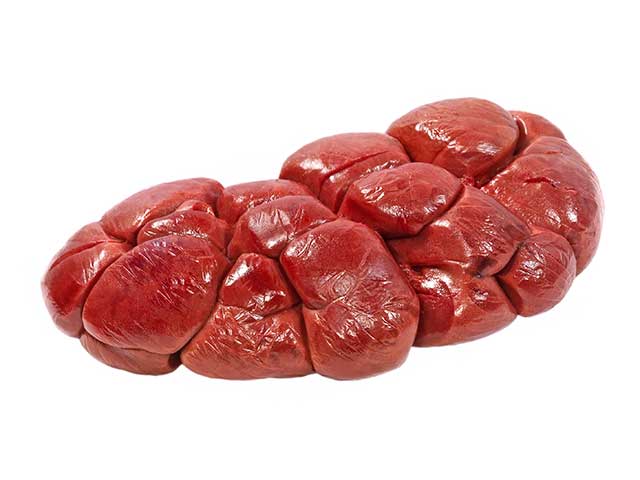
Kidney has not been so popular in recent decades, but it played a big part in traditional cuisine.
This nutritious type of organ meat features in several old recipes such as steak and kidney pie and devilled kidneys.
Beef kidney is quite strong-tasting compared to other kidney varieties, but some people find the flavor enjoyable.
However, it is worth noting that beef kidney can be quite tough if not cooked for long enough. It is also not as tender as lamb or pork kidney.
Nutrition Facts
Here is the nutrition profile of beef kidney per 100 grams.
| Nutrient | Amount |
| Calories | 103 kcal |
| Carbohydrate | 0.3 g |
| Fat | 3.1 g |
| Saturated Fat | 0.9 g |
| Monounsaturated Fat | 0.6 g |
| Polyunsaturated Fat | 0.5 g |
| Protein | 17.4 g |
| Vitamin A | 28% DV |
| Vitamin C | 16% DV |
| Vitamin D | 8% DV |
| Vitamin E | 1% DV |
| Vitamin K | 0% DV |
| Vitamin B1 | 24% DV |
| Vitamin B2 | 167% DV |
| Vitamin B3 | 40% DV |
| Folate | 25% DV |
| Vitamin B5 | 40% DV |
| Vitamin B6 | 51% DV |
| Vitamin B12 | 458% DV |
| Calcium | 1% DV |
| Copper | 21% DV |
| Iron | 26% DV |
| Magnesium | 4% DV |
| Manganese | 7% DV |
| Phosphorus | 26% DV |
| Potassium | 7% DV |
| Selenium | 201% DV |
| Sodium | 8% DV |
| Zinc | 13% DV |
Benefits
- Beef kidney is extremely rich in B vitamins, micronutrients that are essential for converting food to energy.
- This organ meat is also a significant source of selenium, a mineral with antioxidant and anti-inflammatory properties.
Key Point: Beef kidney provides a substantial source of B vitamins and selenium. It is also rich in protein.
3) Beef Spleen
Beef spleen is an interesting organ meat that offers more vitamin C than many fruits.
Since the spleen is one of the lesser known varieties of organ meat, the following diagram shows the location;
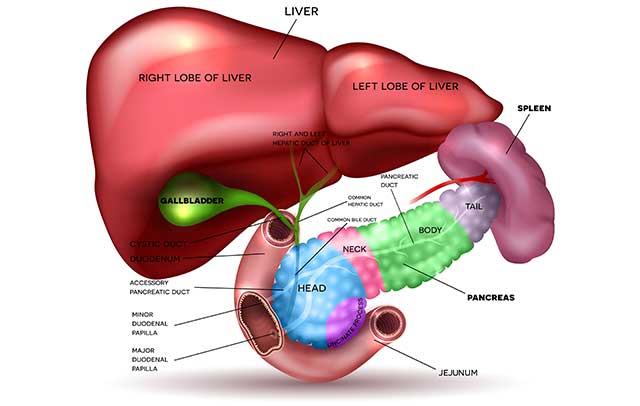
As you can see, the spleen is located at the tail end of the pancreas.
In the body, the spleen is responsible for filtering blood, and it plays a role in immune response.
Nutrition Facts
Here is the nutrition profile of beef spleen per 100 grams.
| Nutrient | Amount |
| Calories | 105 kcal |
| Carbohydrate | 0 g |
| Fat | 3.0 g |
| Saturated Fat | 1.0 g |
| Monounsaturated Fat | 0.8 g |
| Polyunsaturated Fat | 0.2 g |
| Protein | 18.3 g |
| Vitamin A | 0% DV |
| Vitamin C | 76% DV |
| Vitamin D | – |
| Vitamin E | – |
| Vitamin K | – |
| Vitamin B1 | 3% DV |
| Vitamin B2 | 22% DV |
| Vitamin B3 | 42% DV |
| Folate | 1% DV |
| Vitamin B5 | 11% DV |
| Vitamin B6 | 4% DV |
| Vitamin B12 | 95% DV |
| Calcium | 1% DV |
| Copper | 8% DV |
| Iron | 248% DV |
| Magnesium | 5% DV |
| Manganese | 4% DV |
| Phosphorus | 30% DV |
| Potassium | 12% DV |
| Selenium | 89% DV |
| Sodium | 4% DV |
| Zinc | 14% DV |
Benefits
- Beef spleen is a rare animal food source of vitamin C, with a 100-gram serving providing nearly 100% of the recommended daily amount.
- Spleen contains a significant amount of selenium, iron, and vitamin B12, all of which play essential roles within the body.
- Considering the low amount of calories and the reasonable serving of protein spleen provides, it is also very protein-dense.
Key Point: Beef spleen provides a wide range of nutrients for very few calories.
4) Chicken Liver

Chicken livers are one of the best-tasting organ meats.
For those who find the flavor and texture of beef liver too strong, chicken liver is very mild in comparison.
Compared to beef liver, chicken livers are slightly lower in calories and nutrients.
Nutrition Facts
Per 100-gram serving, chicken livers provide;
| Nutrient | Amount |
| Calories | 116 kcal |
| Carbohydrate | 0 g |
| Fat | 4.8 g |
| Saturated Fat | 1.6 g |
| Monounsaturated Fat | 1.2 g |
| Polyunsaturated Fat | 1.3 g |
| Protein | 16.9 g |
| Vitamin A | 222% DV |
| Vitamin C | 30% DV |
| Vitamin D | Varies |
| Vitamin E | 4% DV |
| Vitamin K | 0% DV |
| Vitamin B1 | 20% DV |
| Vitamin B2 | 105% DV |
| Vitamin B3 | 49% DV |
| Folate | 147% DV |
| Vitamin B5 | 62% DV |
| Vitamin B6 | 43% DV |
| Vitamin B12 | 276% DV |
| Calcium | 1% DV |
| Copper | 25% DV |
| Iron | 50% DV |
| Magnesium | 5% DV |
| Manganese | 13% DV |
| Phosphorus | 30% DV |
| Potassium | 7% DV |
| Selenium | 78% DV |
| Sodium | 3% DV |
| Zinc | 18% DV |
Benefits
- Chicken liver contains significant amounts of B vitamins, selenium, and vitamin A.
- In addition to the wide range of nutrients, chicken liver also provides a decent serving of dietary protein.
- Many people find the texture and flavor of organ meats to be offputting. However, chicken livers are softer and milder in flavor, and they are a good introduction to organ meat.
Key Point: Chicken livers offer a milder flavor than beef or lamb liver, and they have an impressive nutrition profile.
5) Heart (Lamb)
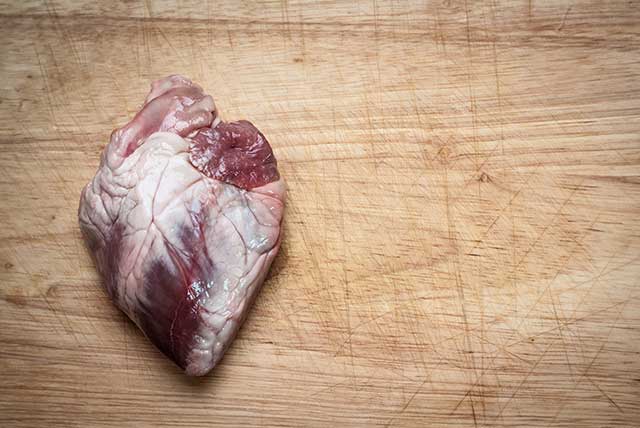
Heart is a nutritious muscular organ meat that provides a rich range of vitamins and minerals.
There are many different varieties available such as beef, chicken, and pork.
However, lamb heart is the most nutrient-dense among the available options, and it contains slightly higher nutritional value across the board.
Nutrition Facts
Lamb heart provides the following nutrients per 100 grams;
| Nutrient | Amount |
| Calories | 122 kcal |
| Carbohydrate | 0.2 g |
| Fat | 5.7 g |
| Saturated Fat | 2.3 g |
| Monounsaturated Fat | 1.6 g |
| Polyunsaturated Fat | 0.5 g |
| Protein | 16.5 g |
| Vitamin A | 0% DV |
| Vitamin C | 8% DV |
| Vitamin D | – |
| Vitamin E | – |
| Vitamin K | – |
| Vitamin B1 | 25% DV |
| Vitamin B2 | 58% DV |
| Vitamin B3 | 31% DV |
| Folate | 0% DV |
| Vitamin B5 | 26% DV |
| Vitamin B6 | 20% DV |
| Vitamin B12 | 171% DV |
| Calcium | 1% DV |
| Copper | 20% DV |
| Iron | 26% DV |
| Magnesium | 4% DV |
| Manganese | 2% DV |
| Phosphorus | 18% DV |
| Potassium | 9% DV |
| Selenium | 46% DV |
| Sodium | 4% DV |
| Zinc | 12% DV |
Benefits
- Heart offers a concentrated source of taurine, an important amino acid that may play a protective role in cardiovascular health.
- Although heart does not contain massive amounts of any one nutrient, it provides a good source of numerous vitamins and minerals.
- Lamb heart is rich in coenzyme Q10 (CoQ10), a fat-soluble compound with purported antioxidant and anti-aging functions.
Key Point: Heart offers a healthy range of nutrients and some further beneficial compounds.
6) Lamb Kidney

Lamb kidney is similar to beef kidney, but it is softer and more tender.
That said, the flavor is a little different, and the best-tasting option will depend on personal preference.
Either way, lamb kidney is a nutrition organ meat packed with essential nutrients.
Nutrition Facts
Lamb kidneys offer the following nutrition profile;
| Nutrient | Amount |
| Calories | 97 kcal |
| Carbohydrate | 0.8 g |
| Fat | 3.0 g |
| Saturated Fat | 1.0 g |
| Monounsaturated Fat | 0.6 g |
| Polyunsaturated Fat | 0.5 g |
| Protein | 15.7 g |
| Vitamin A | 6% DV |
| Vitamin C | 18% DV |
| Vitamin D | – |
| Vitamin E | – |
| Vitamin K | – |
| Vitamin B1 | 41% DV |
| Vitamin B2 | 132% DV |
| Vitamin B3 | 38% DV |
| Folate | 7% DV |
| Vitamin B5 | 42% DV |
| Vitamin B6 | 11% DV |
| Vitamin B12 | 872% DV |
| Calcium | 1% DV |
| Copper | 22% DV |
| Iron | 35% DV |
| Magnesium | 4% DV |
| Manganese | 6% DV |
| Phosphorus | 25% DV |
| Potassium | 8% DV |
| Selenium | 181% DV |
| Sodium | 6% DV |
| Zinc | 15% DV |
Benefits
- Lamb kidney offers a substantial amount of vitamin B12, and it is a good provider of nutrients in the B vitamin group.
- Offers all the benefits of beef liver, but with a slightly higher amount of most vitamins and minerals.
Key Point: Lamb kidneys are the most nutritious variety of kidney, and they have a softer texture than their beef or pork counterparts.
7) Lamb Liver

Similar to lamb kidneys, lamb liver tops other commonly available liver meat in nutritional value.
However, the difference is only small, so the best choice is whichever option suits your taste preferences.
Nutrition Facts
The nutrient profile of lamb liver per 100 grams is as follows;
| Nutrient | Amount |
| Calories | 139 kcal |
| Carbohydrate | 1.8 g |
| Fat | 5.0 g |
| Saturated Fat | 1.9 g |
| Monounsaturated Fat | 1.1 g |
| Polyunsaturated Fat | 0.7 g |
| Protein | 20.4 g |
| Vitamin A | 492% DV |
| Vitamin C | 7% DV |
| Vitamin D | Varies |
| Vitamin E | – |
| Vitamin K | – |
| Vitamin B1 | 23% DV |
| Vitamin B2 | 214% DV |
| Vitamin B3 | 81% DV |
| Folate | 58% DV |
| Vitamin B5 | 61% DV |
| Vitamin B6 | 45% DV |
| Vitamin B12 | 1501% DV |
| Calcium | 1% DV |
| Copper | 349% DV |
| Iron | 41% DV |
| Magnesium | 5% DV |
| Manganese | 9% DV |
| Phosphorus | 36% DV |
| Potassium | 9% DV |
| Selenium | 118% DV |
| Sodium | 3% DV |
| Zinc | 31% DV |
Benefits
- Lamb liver is an incredibly nutritious organ meat; it provides 1501% of the DV for vitamin B12, 492% DV for vitamin A, and 349% DV for copper.
- Similar to beef liver, lamb contains a rich source of retinol, the “pre-formed” and bio-available form of vitamin A.
Key Point: Lamb liver is arguably the most nutrient-dense commonly available food.
8) Liverwurst

Unlike the other foods on this list, liverwurst is not an actual organ meat.
However, it is an organ meat product that contains a blend of several different ingredients.
Although the ingredient profile and recipe will vary from brand to brand, liverwurst usually contains a mix of pork liver, meat, fat, and various spices.
Liverwurst is a German product, and it is otherwise known as liver sausage.
Nutrition Facts
A typical liverwurst sausage offers the following nutritional values per 100 grams;
| Nutrient | Amount |
| Calories | 326 kcal |
| Carbohydrate | 2.2 g |
| Fat | 28.5 g |
| Saturated Fat | 10.6 g |
| Monounsaturated Fat | 13.3 g |
| Polyunsaturated Fat | 2.6 g |
| Protein | 14.1 g |
| Vitamin A | 553% DV |
| Vitamin C | 0% DV |
| Vitamin D | – |
| Vitamin E | – |
| Vitamin K | – |
| Vitamin B1 | 18% DV |
| Vitamin B2 | 61% DV |
| Vitamin B3 | 21% DV |
| Folate | 8% DV |
| Vitamin B5 | 30% DV |
| Vitamin B6 | 9% DV |
| Vitamin B12 | 224% DV |
| Calcium | 3% DV |
| Copper | 12% DV |
| Iron | 36% DV |
| Magnesium | 3% DV |
| Manganese | 8% DV |
| Phosphorus | 23% DV |
| Potassium | 5% DV |
| Selenium | 83% DV |
| Sodium | 36% DV |
| Zinc | 15% DV |
Benefits
- Liverwurst is very adaptable, and you can use sliced liverwurst in a variety of ways. Also, some versions of liverwurst are spreadable, which further increases the sausage’s adaptability.
- Since liverwurst is a mixture of meat, fat, and a variety of spices, it does not have the strong taste and texture of pure organ meats. As a result, it can be a good choice for those who don’t typically like organ meat.
- As it contains liver, liverwurst is an excellent source of vitamin A.
Key Point: Liverwurst is a tasty and versatile organ meat product.
9) Pork Kidney

Pork kidney is one of the most common kinds of organ meat, and it is a nutritious, healthy choice.
On the downside, pork kidneys can have a tough texture depending on the preparation and cooking method.
Nutrition Facts
Per 100 grams, here is the nutrient profile for pork kidneys;
| Nutrient | Amount |
| Calories | 100 kcal |
| Carbohydrate | 0 g |
| Fat | 3.3 g |
| Saturated Fat | 1.0 g |
| Monounsaturated Fat | 1.1 g |
| Polyunsaturated Fat | 0.3 g |
| Protein | 16.5 g |
| Vitamin A | 4% DV |
| Vitamin C | 22% DV |
| Vitamin D | – |
| Vitamin E | – |
| Vitamin K | – |
| Vitamin B1 | 23% DV |
| Vitamin B2 | 100% DV |
| Vitamin B3 | 41% DV |
| Folate | 10% DV |
| Vitamin B5 | 31% DV |
| Vitamin B6 | 22% DV |
| Vitamin B12 | 142% DV |
| Calcium | 1% DV |
| Copper | 31% DV |
| Iron | 27% DV |
| Magnesium | 4% DV |
| Manganese | 6% DV |
| Phosphorus | 20% DV |
| Potassium | 7% DV |
| Selenium | 271% DV |
| Sodium | 5% DV |
| Zinc | 18% DV |
Benefits
- Pork kidneys provide a decent range of nutrients and a good source of protein for minimal calories.
- Supply more than 100% of the daily value for selenium, vitamin B2, and vitamin B12.
Key Point: Pork kidneys are cheap and affordable organ meats that have an excellent nutrition profile.
10) Sweetbreads
If you haven’t heard of sweetbreads before, then you are probably wondering why sugary bread is on a list of organ meats.
Despite the confusing name, sweetbread has nothing to do with bread, and it is the culinary name for the thymus and pancreas organs.
Compared to other organ meats, sweetbreads are much higher in fat and lower in dietary protein.
A sauteed sweetbread look like this;

Nutrition Facts
Sweetbreads offer the following nutrients per 100 grams;
| Nutrient | Amount |
| Calories | 236 kcal |
| Carbohydrate | 0 g |
| Fat | 20.4 g |
| Saturated Fat | 7.0 g |
| Monounsaturated Fat | 7.0 g |
| Polyunsaturated Fat | 3.8 g |
| Protein | 12.2 g |
| Vitamin A | 0% DV |
| Vitamin C | 57% DV |
| Vitamin D | – |
| Vitamin E | – |
| Vitamin K | – |
| Vitamin B1 | 7% DV |
| Vitamin B2 | 20% DV |
| Vitamin B3 | 17% DV |
| Folate | 0% DV |
| Vitamin B5 | 30% DV |
| Vitamin B6 | 8% DV |
| Vitamin B12 | 35% DV |
| Calcium | 1% DV |
| Copper | 2% DV |
| Iron | 12% DV |
| Magnesium | 3% DV |
| Manganese | 6% DV |
| Phosphorus | 39% DV |
| Potassium | 10% DV |
| Selenium | 26% DV |
| Sodium | 4% DV |
| Zinc | 14% DV |
Benefits
- Sweetbreads offer a rare animal food source of vitamin C.
- Likely due to the fat content, sweetbreads do not have the strong flavor and texture that other organ meats possess. Sweetbreads have a soft and tender texture alongside a mild flavor.
Key Point: Sweetbreads are an unusual type of organ meat, but they are rich in nutrients and taste good.
Concerns About Organ Meat
Generally speaking, organ meats are very healthy and offer a wide range of benefits.
However, there is perhaps one legitimate concern to be aware of.
Notably, liver contains so much vitamin A that we can easily consume too much of it.
While there is no need to worry about a semi-regular intake, consuming large portions of liver every day could potentially lead to hypervitaminosis A (vitamin A toxicity).
Final Thoughts
Organ meats are packed with nutritional value and incorporating them into our diet is an excellent way to add an impressive range of essential nutrients.
For those who don’t like typical organ meats such as kidney and liver, it may be worth looking into liverwurst or sweetbreads.
All the options on this list are nutritious choices and make great additions to a healthy diet.
Source: Article by Michael Joseph (https://www.nutritionadvance.com/organ-meats/)
